
CELEBRITY MASTER CHEF DR. KAVIRAJ KHIALANI
Introduction To Blood Pressure:
Blood pressure (BP) is the pressure of circulating blood against the walls of blood vessels. Most of this pressure results from the heart pumping blood through the circulatory system. When used without qualification, the term “blood pressure” refers to the pressure in a brachial artery, where it is most commonly measured. Blood pressure is usually expressed in terms of the systolic pressure (maximum pressure during one heartbeat) over diastolic pressure (minimum pressure between two heartbeats) in the cardiac cycle.
Normal Range For Blood Pressure:
A normal blood pressure reading for an adult is blood pressure that’s below 120/80 mm Hg and above 90/60 mm Hg. What’s considered elevated blood pressure? Blood pressure numbers that are higher than 120/80 mm Hg are a warning sign. It means you need to pay attention to your blood pressure and focus on heart-healthy habits.
Reason For Rise In Blood Pressure:
- Underlying health conditions
While most cases of hypertension are primary (many-faceted), several underlying health conditions can contribute to or cause secondary hypertension. Treating these conditions can often reverse hypertension.
They include:
- elevated blood pressure
- overweight or obesity
- diabetes
- chronic kidney disease
- pregnancy
- certain heart irregularities
- Lack of physical activity
Getting too little physical exercise can negatively impact you in many ways. It could aggravate mental health conditions like anxiety and depression and lead to being overweight.
Exercising can help you maintain a moderate weight or lose weight if necessary. That can positively affect your blood pressure and give you more energy and a sense of well-being.
The AHA suggests the following, based on guidelines trusted Source from the Department of Health and Human Services:
- Aim for at least 150 minutes per week of moderate intensity aerobic activity or 75 minutes per week of vigorous aerobic exercise.
- Perform moderate to high intensity muscle strengthening resistance training at least 2 days per week.
- Spend less time sitting.
- Work up to more activity — at least 300 minutes (5 hours) per week.
- Gradually increase the amount and intensity of your exercise.
- Alcohol
Heavy alcohol consumption can harm your overall health, including your cardiovascular health. It can contribute to or worsen hypertension. It can also increase your risk of diabetes and several cancers.
The AHA recommends limiting alcohol consumption to two drinks per day for males and one for females. A drink is:
- 12 ounces of beer
- 4 ounces of wine
- 1.5 ounces of 80-proof spirits
- 1 ounce of 100-proof spirits
But even moderate alcohol consumption has its drawbacks. A 2019 studyof more than 17,000 people suggests that moderate consumption (7 to 13 drinks a week) can substantially raise your risk of hypertension. A 2020 study trusted source also found a link between moderate alcohol consumption and high blood pressure in people with type 2 diabetes.
4. Smoking
Smoking is the leading cause of preventable death in the United States. Smoking can contribute to many life threatening conditions, including heart attack, stroke, lung disease, and several cancers.
That said, the relationship between hypertension and smoking isn’t yet clear. But smoking does lead to temporary spikes in blood pressure. It also contributes to atheroscleresois, the hardening of your arteries. Stiff arteries cause an increase in blood pressure.
If you smoke, the AHA recommends quitting as soon as you can. Smoking Cessation has numerous health benefits, some of them within 20 mins.
- Not enough sleep
According to the CDC Trusted Source, most people older than 18 years need at least 7 hours of sleep a night for optimum health. But many people don’t get enough. That can affect your health, especially if you have high blood pressure.
That’s because when you sleep normally, your blood pressure goes down. That gives your body a break. Having insomnia or other sleep problems, or regularly getting too little sleep, means your body doesn’t get as much of a break.
You can get enough rest by practicing good sleep hygiene. The CDC offers the following tips:
- Go to bed at the same time each night and get up at the same time each morning, including on the weekends.
- Get enough natural light, especially earlier in the day.
- Get enough physical activity during the day. Try not to exercise within a few hours of bedtime.
- Avoid artificial light, especially within a few hours of bedtime. Use a blue light filter on your computer or smartphone.
- Don’t eat or drink within a few hours of bedtime; avoid alcohol and foods high in fat or sugar.
- Keep your bedroom cool, dark, and quiet.
Medical conditions that can cause low blood pressure include:
- Changes during pregnancy cause blood vessels to expand rapidly. The changes may cause blood pressure to drop. Low blood pressure is common in the first 24 weeks of pregnancy. Blood pressure usually returns to pre-pregnancy levels after giving birth.
- Heart and heart valve conditions.A heart attack, heart failure, heart valve disease and an extremely low heart rate (bradycardia) can cause low blood pressure.
- Hormone-related diseases (endocrine disorders).Conditions affecting the parathyroid or adrenal glands, such as Addison’s disease, may cause blood pressure to drop. Low blood sugar (hypoglycemia) and, sometimes, diabetes also may lower blood pressure.
- When the body doesn’t have enough water, the amount of blood in the body (blood volume) decreases. This can cause blood pressure to drop. Fever, vomiting, severe diarrhea, overuse of diuretics and strenuous exercise can lead to dehydration.
- Blood loss.Losing a lot of blood, such as from an injury or internal bleeding, also reduces blood volume, leading to a severe drop in blood pressure.
- Severe infection (septicemia).When an infection in the body enters the bloodstream, it can lead to a life-threatening drop in blood pressure called septic shock.
- Severe allergic reaction (anaphylaxis).Symptoms of a severe allergic reaction include a sudden and dramatic drop in blood pressure.
- Lack of nutrients in the diet.Low levels of vitamin B-12, folate and iron can keep the body from producing enough red blood cells (anemia), which can lead to low blood pressure.
How To Maintain The Balance On The Levels Of Blood Pressure:
- One reason exercise is so effective at controlling blood pressure is because it stimulates your body to release a substance called nitric acid. Nitric acid causes blood vessels to open up, which reduces blood pressure. Exercise also helps to strengthen your heart muscle, reduce stress, and aid weight loss.
- Lose excess weight.There’s no getting around the fact that blood pressure goes up as the pounds pile on. Being overweight increases your risk for heart disease and diabetes, too. Losing even 10 pounds can start to make your blood pressure go back down.
- Eat healthily.Eating the right type of diet can lower your risk for high blood pressure or help you return to normal blood pressure. Clinical studies show that a diet high in fruits, vegetables, low-fat dairy, whole grains, poultry, fish, and nuts really works. You also need to avoid fats, red meat, and excess sugar.
- Shake the salt habit.Your body only needs about 500 milligrams of salt a day, but if you are like the average American you may be consuming up to 9,000 mg a day. Studies show that high salt leads to high blood pressure. Current recommendations are to limit salt intake to 2,400 mg per day, the equivalent of about one teaspoon.
- Put the brakes on smoking and drinking.These are two other bad habits to avoid if you want to keep a normal blood pressure. Alcohol raises blood pressure and adds empty calories. A safe amount of alcohol is only one drink a day for women and two for men. Smoking is not safe in any amount. Nicotine causes blood vessels to constrict and that raises blood pressure. Quitting will also lower your risk of cancer and heart disease.
The only way to know if you have high blood pressure or normal blood pressure is to have a blood pressure reading done by a trained healthcare provider. The American Heart Association recommends a blood pressure reading at least once every two years. If you have had a recent blood pressure reading and you have normal blood pressure, don’t take it for granted. Remember hypertension is a common and sometimes silent killer. Push yourself away from the computer, turn off the television, get active, eat your fruits and vegetables, and kick any bad habits.
5 Recipes To Go For To keep Blood Pressure In Normal Ranges:
JOWAR ROTI
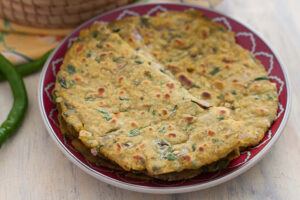
Ingredients:
– 2 cups Jowar flour (also known as sorghum flour)
– Warm water for kneading the dough
– Salt to taste
– Ghee (clarified butter) or oil for cooking
Instructions:
- In a large mixing bowl, take the jowar flour and add salt to taste. Give it a quick mix.
- Gradually add warm water to the flour and knead it well. Continue adding water until a soft, pliable dough is formed. The dough should be non-sticky.
- Divide the dough into equal-sized balls.
- Take a ball of dough and flatten it using your hands or a rolling pin on a clean surface. Dust the surface and rolling pin with some jowar flour to prevent sticking.
- Roll the dough into a circular shape, similar to a chapati or roti, about 6-7 inches in diameter.
- Heat a tawa or griddle on medium heat.
- Carefully place the rolled jowar roti on the heated tawa or griddle.
- Cook one side for a minute or until you notice small bubbles forming on the surface.
- Flip the roti and cook the other side for another minute.
- Apply ghee or oil on both sides of the roti as per your preference.
- Repeat the same process for the remaining dough balls.
- Serve the hot and freshly cooked jowar rotis with your choice of accompaniment like dal, sabzi, or pickle.
Note: Jowar rotis are traditionally thicker than wheat rotis, so don’t roll them too thin. Also, ensure that the tawa or griddle is well-heated before you start cooking the rotis.
CUCUMBER RAITA:
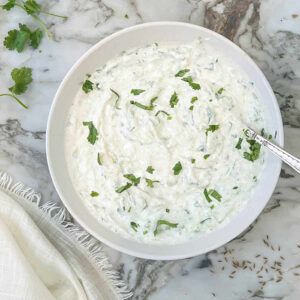
Ingredients:
– 1 medium-sized cucumber
– 1 cup plain yogurt
– 1/4 teaspoon roasted cumin powder
– 1/4 teaspoon black salt (optional)
– 1/2 teaspoon salt (or to taste)
– 1/4 teaspoon red chili powder
– 2 tablespoons chopped fresh cilantro (coriander leaves)
– Mint leaves for garnish (optional)
Instructions:
- Peel the cucumber and grate it using a grater or finely chop it into small pieces. If you prefer a smoother raita, you can also blend the cucumber in a food processor or blender.
- In a mixing bowl, whisk the yogurt until it becomes smooth and creamy.
- Add the grated or chopped cucumber to the yogurt and mix well.
- Add roasted cumin powder, black salt (if using), regular salt, and red chili powder to the mixture. Stir until all the ingredients are well combined.
- Taste the raita and adjust the salt or spices if needed.
- Finally, add chopped cilantro (coriander leaves) to the raita and give it a gentle stir.
- Transfer the raita to a serving bowl and garnish with some fresh mint leaves if desired.
- Refrigerate for at least half an hour before serving to allow the flavors to blend together.
Cucumber raita is a refreshing and cooling side dish that complements many Indian dishes, especially biryani, pulao, or any spicy curry.
DAHI BHINDI:
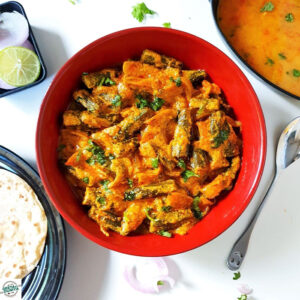
Ingredients:
– 250 grams okra (bhindi), washed and dried
– 1 cup plain yogurt (dahi), whisked
– 1 medium-sized onion, finely chopped
– 2 tomatoes, pureed
– 2 teaspoons ginger-garlic paste
– 1 teaspoon cumin seeds
– 1 teaspoon turmeric powder
– 1 teaspoon red chili powder (adjust according to your spice preference)
– 1 teaspoon coriander powder
– 1/2 teaspoon garam masala
– Salt to taste
– 2 tablespoons oil for frying
– Fresh cilantro (coriander leaves) for garnish
Instructions:
- Trim the ends of the okra and slice them into about 1-inch pieces.
- Heat oil in a non-stick pan or skillet over medium-high heat.
- Add the okra pieces and sauté for 6-8 minutes until they turn slightly crisp and tender. Remove them from the pan and set aside.
- In the same pan, add cumin seeds and let them splutter. Then add chopped onions and ginger-garlic paste. Sauté until the onions turn translucent.
- Add the tomato puree and cook for a few minutes until the raw smell disappears.
- Reduce the heat to low and add turmeric powder, red chili powder, coriander powder, and salt. Mix well and cook for a minute or two.
- Add the whisked yogurt to the pan and mix it with the masala. Cook on low heat for about 4-5 minutes, stirring occasionally.
- Add the sautéed okra (bhindi) to the pan and gently combine it with the yogurt mixture. Cook for another 2-3 minutes until the flavors blend together.
- Sprinkle garam masala over the dish and garnish with fresh cilantro leaves.
- Serve hot with roti or rice.
Dahi Bhindi is a flavorful dish where the tanginess of the yogurt complements the earthiness of okra.
MOONG DAL CHILLA:
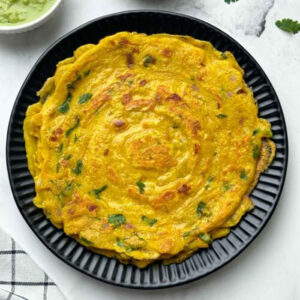
Ingredients:
– 1 cup moong dal (split yellow lentils)
– 1 small onion, finely chopped
– 1 small tomato, finely chopped
– 1 green chili, finely chopped
– 1/4 cup fresh coriander leaves, chopped
– Salt to taste
– 1/4 teaspoon turmeric powder
– 1/2 teaspoon cumin powder
– Oil for cooking
Instructions:
- Rinse the moong dal and soak it in water for 4-5 hours. Then, drain the water.
- Blend the soaked moong dal with a little water to make a smooth batter.
- Transfer the batter to a bowl and add chopped onion, tomato, green chili, coriander leaves, salt, turmeric powder, and cumin powder. Mix well.
- Heat a non-stick pan and brush it with oil.
- Pour a ladleful of the batter onto the pan and spread it in a circular motion to make a thin chilla.
- Cook on medium heat until the bottom side turns golden brown. Flip and cook the other side as well.
- Repeat the process with the remaining batter.
- Serve hot with chutney or yogurt.
RAJMA SALAD:
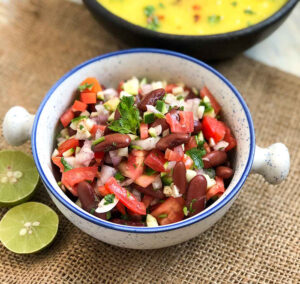
Ingredients:
– 1 cup cooked rajma (kidney beans)
– 1 small onion, finely chopped
– 1 small tomato, finely chopped
– 1 cucumber, finely chopped
– 1 green chili, finely chopped
– 1/4 cup fresh coriander leaves, chopped
– Salt to taste
– 1/2 teaspoon chaat masala
– 1/2 teaspoon lemon juice
Instructions:
- In a bowl, combine the cooked rajma, chopped onion, tomato, cucumber, green chili, and coriander leaves.
- Sprinkle salt, chaat masala, and lemon juice over the mixture.
- Toss everything together until well combined.
- Let the salad sit for a few minutes to allow the flavors to blend.
- Serve the Rajma Salad as a healthy and refreshing side dish.
Celebrity Master Chef Dr Kaviraj Khialani is a Mumbai-based hotel-restaurant and food consultant. He is specialised in over 33 international cuisines and has quality experience with hotels and airlines as a part of his long journey of over two decades in his chosen field. Chef Kaviraj is a renowned author, academician, food designer, writer and has also been awarded several national awards and global recognitions for his talent & outstanding achievements. Besides having been featured on several food shows on ColorsTV and Star Plus he is a mentor, coach and guide to aspiring to be future chefs and hoteliers of tomorrow.
He can be contacted at twitter: @kaviraj_chef, Mobile: 91 9820939336. Mail: chefkaviraj249@gmail.com
Also Read:
Also Read:













